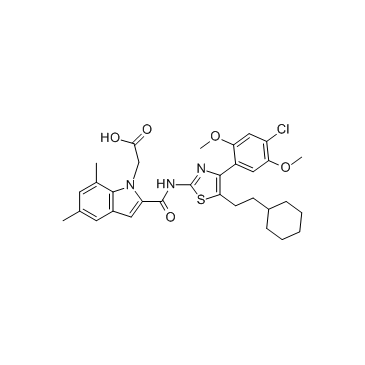| Description |
SR 146131 is a potent, orally available, and selective nonpeptide (cholecystokinin 1) receptor agonist.
|
| Related Catalog |
|
| Target |
Cholecystokinin 1 receptor[1]
|
| In Vitro |
SR 146131 inhibits in the binding of [125I]-BH-CCK-8S to CCK1sites on 3T3-hCCK1 cell membranes with an IC50 value of 0.56 ± 0.10 nM. At much higher concentrations, SR 146131 also inhibits the binding of radiolabeled CCK to CCK2sites in CHO-hCCK2 membranes with an IC50 of 162 ± 27 nM. SR 146131 is a potent CCK1 agonist on several intracellular events linked to CCK1 receptor activation in various cell types: on [Ca2+]i release and IP1 formation, SR 146131 appears as a full CCK1 receptor agonist in the 3T3-hCCK1 cells, but a partial CCK1receptor agonist on MAPK activation and early gene expression in this cell line. SR 146131 also acts as a partial agonist in the two neuroblastoma cell lines[1].
|
| In Vivo |
SR 146131 completely inhibits gastric and gallbladder emptying in mice (ED50 of 66 and 2.7 μg/kg p.o., respectively). SR 146131 dose dependently reduces food intake in fasted rats (from 0.1 mg/kg p.o.), in nonfasted rats in which food intake has been highly stimulated by the administration of neuropeptide Y (1–36) (from 0.3 mg/kg p.o.), in fasted gerbils (from 0.1 mg/kg p.o.), and in marmosets maintained on a restricted diet (from 3 mg/kg p.o.). SR 146131 (10 mg/kg p.o.) also increases the number of Fos-positive cells in the hypothalamic paraventricular nucleus of rats. Locomotor activity of mice is reduced by orally administered SR 146131 (from 0.3 mg/kg p.o.)[1].
|
| Cell Assay |
3T3-hCCK1 cells grown to subconfluence in 6-well cluster plates are washed with fresh medium. Twenty-four hours later, the cells are stimulated for 15 min with various concentrations of CCK-8S or SR 146131[1].
|
| Animal Admin |
Rats[1] Male Sprague-Dawley rats are fasted for 18 h, and allowed access to food for only 6 h between 10 AM and 4 PM each day. Water is available ad libitum. At the end of this adaptation phase, rats are administered SR 146131 (0.03-3 mg/kg p.o.). One hour after SR 146131 administration, a weighed amount of food is introduced into the cage, and food intake is measured 1, 3, 6, and 23 h after SR 146131 administration[1]. Mice[1] SR 146131 (0.01-1 pg) is solubilized in DMSO (1 mg/mL), diluted to the required concentrations with water, and injected (in 1 μL) into one striatum in awake, hand-restrained female CD1 mice (25-30 g). After injection, the animals are placed individually in Plexiglas cages (10 × 10 × 15 cm). Turning behavior in mice is monitored[1].
|
| References |
[1]. Bignon E, et al. SR146131: a new potent, orally active, and selective nonpeptide cholecystokinin subtype 1 receptor agonist. I. In vitro studies. J Pharmacol Exp Ther. 1999 May;289(2):742-51. [2]. Bignon E, et al. SR146131: a new potent, orally active, and selective nonpeptide cholecystokinin subtype 1 receptor agonist. II. In vivo pharmacological characterization. J Pharmacol Exp Ther. 1999 May;289(2):752-61.
|
